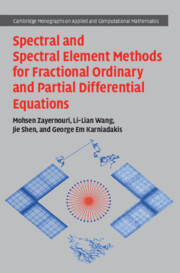Refine search
Actions for selected content:
28969 results in Differential and integral equations, dynamical systems and control theory
STABILITY ANALYSIS FOR STOCHASTIC MCKEAN–VLASOV EQUATION
- Part of
-
- Journal:
- The ANZIAM Journal / Volume 67 / 2025
- Published online by Cambridge University Press:
- 06 November 2024, e6
-
- Article
- Export citation
ETS volume 44 issue 12 Cover and Back matter
-
- Journal:
- Ergodic Theory and Dynamical Systems / Volume 44 / Issue 12 / December 2024
- Published online by Cambridge University Press:
- 06 November 2024, pp. b1-b2
- Print publication:
- December 2024
-
- Article
-
- You have access
- Export citation
ETS volume 44 issue 12 Cover and Front matter
-
- Journal:
- Ergodic Theory and Dynamical Systems / Volume 44 / Issue 12 / December 2024
- Published online by Cambridge University Press:
- 06 November 2024, pp. f1-f2
- Print publication:
- December 2024
-
- Article
-
- You have access
- Export citation
Effective count of square-tiled surfaces with prescribed real and imaginary foliations in connected components of strata
- Part of
-
- Journal:
- Ergodic Theory and Dynamical Systems / Volume 45 / Issue 3 / March 2025
- Published online by Cambridge University Press:
- 06 November 2024, pp. 649-662
- Print publication:
- March 2025
-
- Article
-
- You have access
- Open access
- HTML
- Export citation
Dynamical behaviour of a logarithmically sensitive chemotaxis model under time-dependent boundary conditions
- Part of
-
- Journal:
- European Journal of Applied Mathematics / Volume 36 / Issue 3 / June 2025
- Published online by Cambridge University Press:
- 04 November 2024, pp. 638-664
-
- Article
-
- You have access
- Open access
- HTML
- Export citation
JMJ volume 23 issue 6 Cover and Back matter
-
- Journal:
- Journal of the Institute of Mathematics of Jussieu / Volume 23 / Issue 6 / November 2024
- Published online by Cambridge University Press:
- 15 November 2024, pp. b1-b2
- Print publication:
- November 2024
-
- Article
-
- You have access
- Export citation
JMJ volume 23 issue 6 Cover and Front matter
-
- Journal:
- Journal of the Institute of Mathematics of Jussieu / Volume 23 / Issue 6 / November 2024
- Published online by Cambridge University Press:
- 15 November 2024, pp. f1-f2
- Print publication:
- November 2024
-
- Article
-
- You have access
- Export citation

Spectral and Spectral Element Methods for Fractional Ordinary and Partial Differential Equations
-
- Published online:
- 31 October 2024
- Print publication:
- 14 November 2024
5 - State Equivalence, State Reduction
- from Part I - Lectures on Basics with Examples
-
- Book:
- Time-Variant and Quasi-separable Systems
- Published online:
- 24 October 2024
- Print publication:
- 31 October 2024, pp 73-86
-
- Chapter
- Export citation
9 - The Kalman Filter as an Application
- from Part I - Lectures on Basics with Examples
-
- Book:
- Time-Variant and Quasi-separable Systems
- Published online:
- 24 October 2024
- Print publication:
- 31 October 2024, pp 136-153
-
- Chapter
- Export citation
7 - Inner Operators and External Factorizations
- from Part I - Lectures on Basics with Examples
-
- Book:
- Time-Variant and Quasi-separable Systems
- Published online:
- 24 October 2024
- Print publication:
- 31 October 2024, pp 95-114
-
- Chapter
- Export citation
3 - LTV (Quasi-separable) Systems
- from Part I - Lectures on Basics with Examples
-
- Book:
- Time-Variant and Quasi-separable Systems
- Published online:
- 24 October 2024
- Print publication:
- 31 October 2024, pp 41-58
-
- Chapter
- Export citation
Index
-
- Book:
- Time-Variant and Quasi-separable Systems
- Published online:
- 24 October 2024
- Print publication:
- 31 October 2024, pp 304-306
-
- Chapter
- Export citation
Frontmatter
-
- Book:
- Time-Variant and Quasi-separable Systems
- Published online:
- 24 October 2024
- Print publication:
- 31 October 2024, pp i-iv
-
- Chapter
- Export citation
4 - System Identification
- from Part I - Lectures on Basics with Examples
-
- Book:
- Time-Variant and Quasi-separable Systems
- Published online:
- 24 October 2024
- Print publication:
- 31 October 2024, pp 59-72
-
- Chapter
- Export citation
2 - Dynamical Systems
- from Part I - Lectures on Basics with Examples
-
- Book:
- Time-Variant and Quasi-separable Systems
- Published online:
- 24 October 2024
- Print publication:
- 31 October 2024, pp 21-40
-
- Chapter
- Export citation
11 - Quasi-separable Moore−Penrose Inversion
- from Part I - Lectures on Basics with Examples
-
- Book:
- Time-Variant and Quasi-separable Systems
- Published online:
- 24 October 2024
- Print publication:
- 31 October 2024, pp 169-182
-
- Chapter
- Export citation
12 - LU (Spectral) Factorization
- from Part II - Further Contributions to Matrix Theory
-
- Book:
- Time-Variant and Quasi-separable Systems
- Published online:
- 24 October 2024
- Print publication:
- 31 October 2024, pp 185-201
-
- Chapter
- Export citation
Part II - Further Contributions to Matrix Theory
-
- Book:
- Time-Variant and Quasi-separable Systems
- Published online:
- 24 October 2024
- Print publication:
- 31 October 2024, pp 183-184
-
- Chapter
- Export citation
1 - A First Example: Optimal Quadratic Control
- from Part I - Lectures on Basics with Examples
-
- Book:
- Time-Variant and Quasi-separable Systems
- Published online:
- 24 October 2024
- Print publication:
- 31 October 2024, pp 3-20
-
- Chapter
- Export citation


